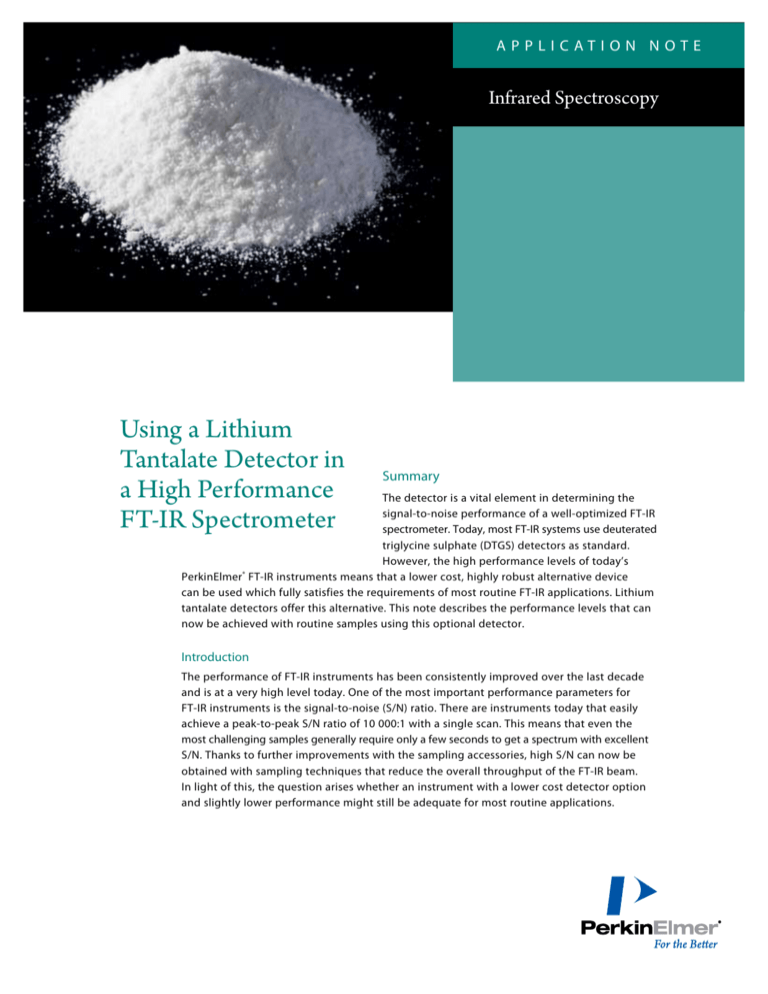
a ppli c a tion N ote
Infrared Spectroscopy
Using a Lithium
Tantalate Detector in
a High Performance
FT-IR Spectrometer
Summary
The detector is a vital element in determining the
signal-to-noise performance of a well-optimized FT-IR
spectrometer. Today, most FT-IR systems use deuterated
triglycine sulphate (DTGS) detectors as standard.
However, the high performance levels of today’s
PerkinElmer® FT-IR instruments means that a lower cost, highly robust alternative device
can be used which fully satisfies the requirements of most routine FT-IR applications. Lithium
tantalate detectors offer this alternative. This note describes the performance levels that can
now be achieved with routine samples using this optional detector.
Introduction
The performance of FT-IR instruments has been consistently improved over the last decade
and is at a very high level today. One of the most important performance parameters for
FT-IR instruments is the signal-to-noise (S/N) ratio. There are instruments today that easily
achieve a peak-to-peak S/N ratio of 10 000:1 with a single scan. This means that even the
most challenging samples generally require only a few seconds to get a spectrum with excellent
S/N. Thanks to further improvements with the sampling accessories, high S/N can now be
obtained with sampling techniques that reduce the overall throughput of the FT-IR beam.
In light of this, the question arises whether an instrument with a lower cost detector option
and slightly lower performance might still be adequate for most routine applications.
Benefits of the lithium tantalate detector
All of the components in an FT-IR instrument influence its
performance. The detector is particularly important. Most
FT-IR instruments use a deuterated triglycine sulphate (DTGS)
detector as standard. It is a thermal detector, which acts
as a pyroelectric bolometer. When the modulated radiation
from the instrument reaches the detector, its electrical
polarizability is changed resulting in a voltage, which is
measured as the detector signal.
The lithium tantalate detector (LiTaO3) is an alternative
pyroelectric detector, which is at least as good as the DTGS
detector with regard to spectral range, responsiveness, and
linearity. Advantages with the LiTaO3 detector include the
lower manufacturing cost of the crystal material compared
to the DTGS and elimination of the need for thermostatting.
Since the DTGS has a Curie point close to room temperature,
its response is very sensitive to temperature changes. Thus,
a DTGS detector has to be carefully Peltier-thermostatted in
order to achieve best performance. The LiTaO3 detector does
not need temperature control. Its associated electronics can
be simpler, which further contributes to cost savings
There is only one disadvantage of the LiTaO3 detector. It has
a lower S/N performance typically by a factor of ca 2 to 4
compared to the DTGS detector. In general, use of an FT-IR
instrument that has a LiTaO3 detector could be a lower cost
option in cases where the ultimate instrument S/N is not
required.
Comparing the performance of a LiTaO3 detector with a
DTGS detector
One of the most powerful applications in mid-infrared
spectroscopy these days is the Diamond ATR technique,
which acquires spectra of virtually any solid or liquid sample
with minimal sample preparation. Typically, the throughput
with such an accessory is only 15% of the total amount of
light in an FT-IR instrument. Use of this technique can show
whether the reduced S/N performance of the LiTaO3 detector
is still sufficient for most applications.
Figure 1 shows the results of such a comparison, where the
analgesic phenacetin powder was measured with the UATR
accessory on two identical Spectrum™ 100 instruments1. One
was equipped with a LiTaO3 and the other with a DTGS detector. All scan conditions were the same. The spectra obtained
were very similar. Small intensity differences can
be observed due to minor variations in the pressures applied.
The spectrum measured with the LiTaO3 detector shows a
slightly higher noise level in the short wavelength range
compared to the DTGS spectrum. Overall, however, this
difference is negligible, and both spectra are well-suited
for unambiguous identification of this material.
An even more challenging test would be to measure a micro
sample on the UATR accessory.
In the spectra depicted in Figure 2, a single human hair was
pressed against the diamond crystal. It is clear that due to
the size of the sample, only a small fraction of the diamond
surface, which, itself, is roughly 1 mm2 in size, is in contact
with the hair sample. Thus, a weaker total absorbance of
the spectrum is expected.
In order to compensate for the lower S/N performance,
16 scans were measured with the LiTaO3 detector and
1 scan with the DTGS detector. The spectra received are
comparable regarding S/N. They show that, even in such
a demanding application, a LiTaO3 detector is suitable to generate spectra with excellent performance if a few
seconds of additional measurement time are spent.
Figure 1. Phenacetin powder measured on Spectrum 100 equipped with
1 bounce UATR accessory using LiTaO3 detector (blue) or DTGS detector
(red). Conditions: 4 cm-1 resolution, 4 scans.
1. Similar data may be obtained using the PerkinElmer Frontier FT-IR or
Spectrum Two FT-IR systems.
2
Figure 2. Single hair measured on Spectrum 100 instrument with 1 bounce
UATR accessory using LiTaO3 detector (blue) or DTGS detector (red).
Conditions: 4 cm-1 resolution, LiTaO3: 16 scans, DTGS: 1 scan).
Conclusion
With high performance FT-IR instruments, a LiTaO3 detector
is a valid option and well suited for most routine applications.
In cases for which ultimate performance is required, a slight
increase of the total measurement time, which is often still
small compared to the total analysis
time, is sufficient to get spectra with excellent S/N ratio.
PerkinElmer, Inc.
940 Winter Street
Waltham, MA 02451 USA
P: (800) 762-4000 or
(+1) 203-925-4602
www.perkinelmer.com
For a complete listing of our global offices, visit www.perkinelmer.com/ContactUs
Copyright ©2007-2010, PerkinElmer, Inc. All rights reserved. PerkinElmer® is a registered trademark of PerkinElmer, Inc. All other trademarks are the property of their respective owners.
007845A_04






